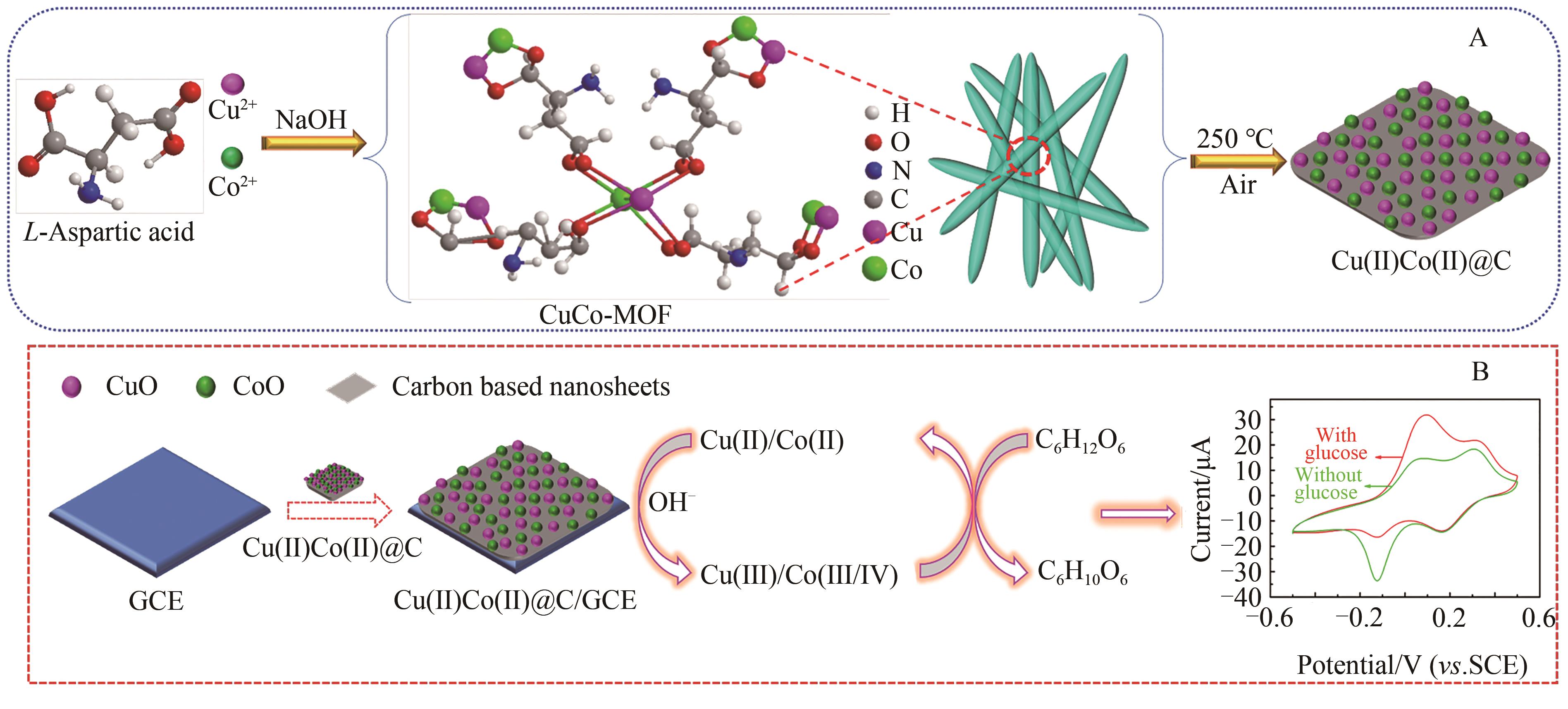
Chinese Journal of Applied Chemistry ›› 2022, Vol. 39 ›› Issue (12): 1891-1902.DOI: 10.19894/j.issn.1000-0518.220099
• Full Papers • Previous Articles Next Articles
Study of Electrochemical Non-enzyme Glucose Sensor Based on Cu(Ⅱ)Co(Ⅱ) Bimetallic Carbon Nanosheets
Xiao-Mei HUANG1,2,3( ), Xiang DENG1,2, Lang-Man XING1, Wei CHEN1, Li SUN1, Xiao-Yu ZHU1
), Xiang DENG1,2, Lang-Man XING1, Wei CHEN1, Li SUN1, Xiao-Yu ZHU1
- 1.Department of Chemistry and Chemical Engineering,Sichuan University of Arts and Science,Dazhou 635000,China
2.Key Laboratory of Exploitation and Study of Distinctive Plants in Education Department of Sichuan Province,Dazhou 635000,China
3.Key Laboratory of Green Chemistry of Sichuan Institutes of Higher Education,Zigong 643000,China
-
Received:2022-04-01Accepted:2022-08-31Published:2022-12-01Online:2022-12-13 -
Contact:Xiao-Mei HUANG -
About author:huangxm917@163.com
-
Supported by:the Scientific Research Fund of the Sichuan Provincial Science and Technology Department(2019YJ0307);the Key Laboratory of Exploitation and Study of Distinctive Plants in Education Department of Sichuan Province(TSZW2005);the Opening Project of Key Laboratory of Green Chemistry of Sichuan Institutes of Higher Education(LYJ1802);Dazhou Municipal Science Project of Technology Bureau Application Foundation(18YYJC0002);the National University Innovation and Entrepreneurship Training Program(202110644011);the Scientific Research Program for College Students of Sichuan University of Arts and Sciences in 2021(X2021Z021)
CLC Number:
Cite this article
Xiao-Mei HUANG, Xiang DENG, Lang-Man XING, Wei CHEN, Li SUN, Xiao-Yu ZHU. Study of Electrochemical Non-enzyme Glucose Sensor Based on Cu(Ⅱ)Co(Ⅱ) Bimetallic Carbon Nanosheets[J]. Chinese Journal of Applied Chemistry, 2022, 39(12): 1891-1902.
share this article
Add to citation manager EndNote|Ris|BibTeX
URL: http://yyhx.ciac.jl.cn/EN/10.19894/j.issn.1000-0518.220099
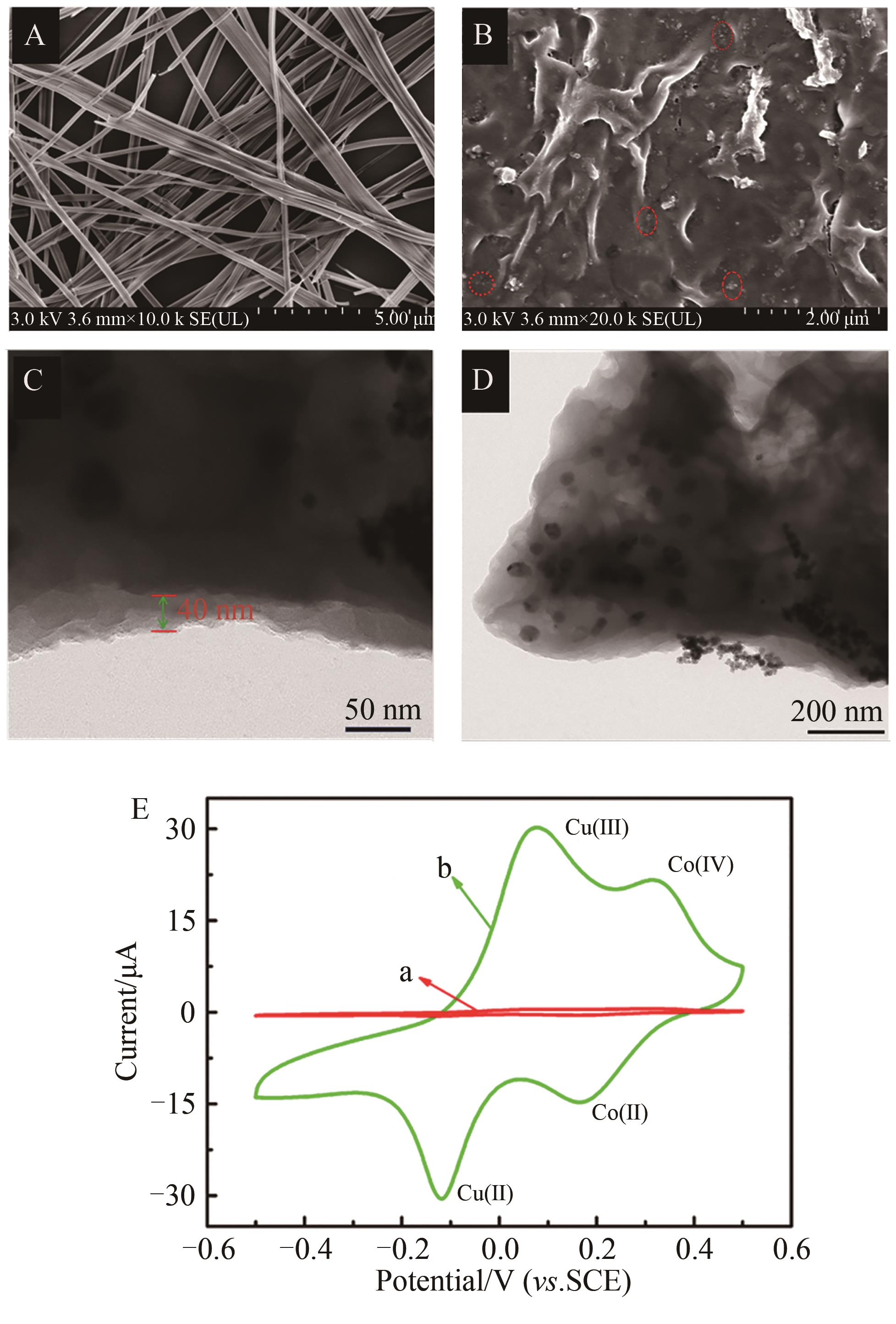
Fig.2 SEM images of CuCo-MOF (A) and Cu(Ⅱ)Co(Ⅱ)@C (B), in the red circle of figure B, there are Cu (Ⅱ) and Co (Ⅱ) nanoparticles; (C) and (D) TEM images of Cu(Ⅱ)Co(Ⅱ)@C; (E) Cyclic voltammetry (CV) curves of bare GCE(a) and Cu(Ⅱ)Co(Ⅱ)@C/GCE(b) in 0.10 mol/L NaOH solution
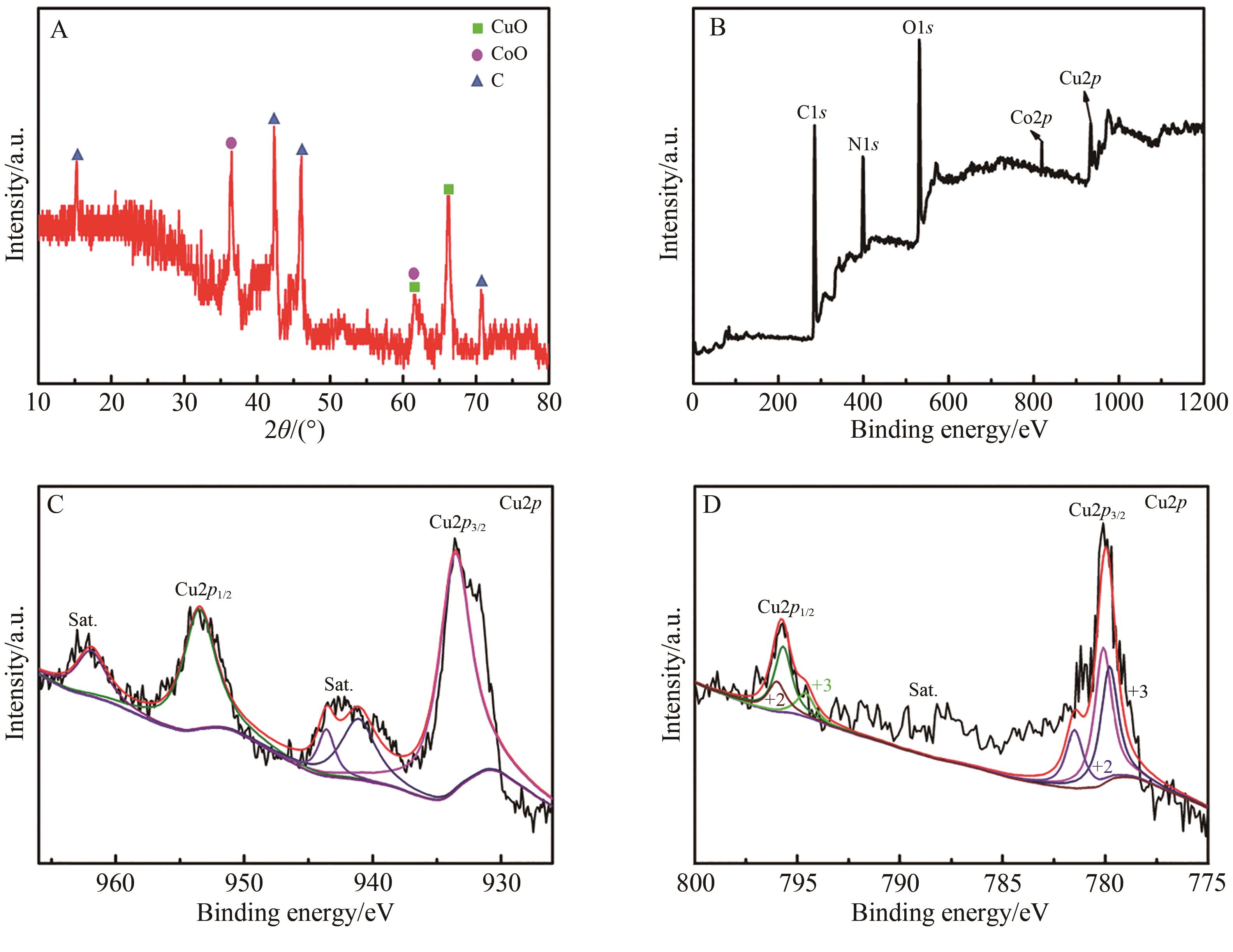
Fig.3 (A) XRD pattern of Cu(Ⅱ)Co(Ⅱ)@C; (B) XPS spectra of Cu(Ⅱ)Co(Ⅱ)@C full scan; (C) and (D) are high-resolution XPS spectra of Cu2p and Co2p, respectively
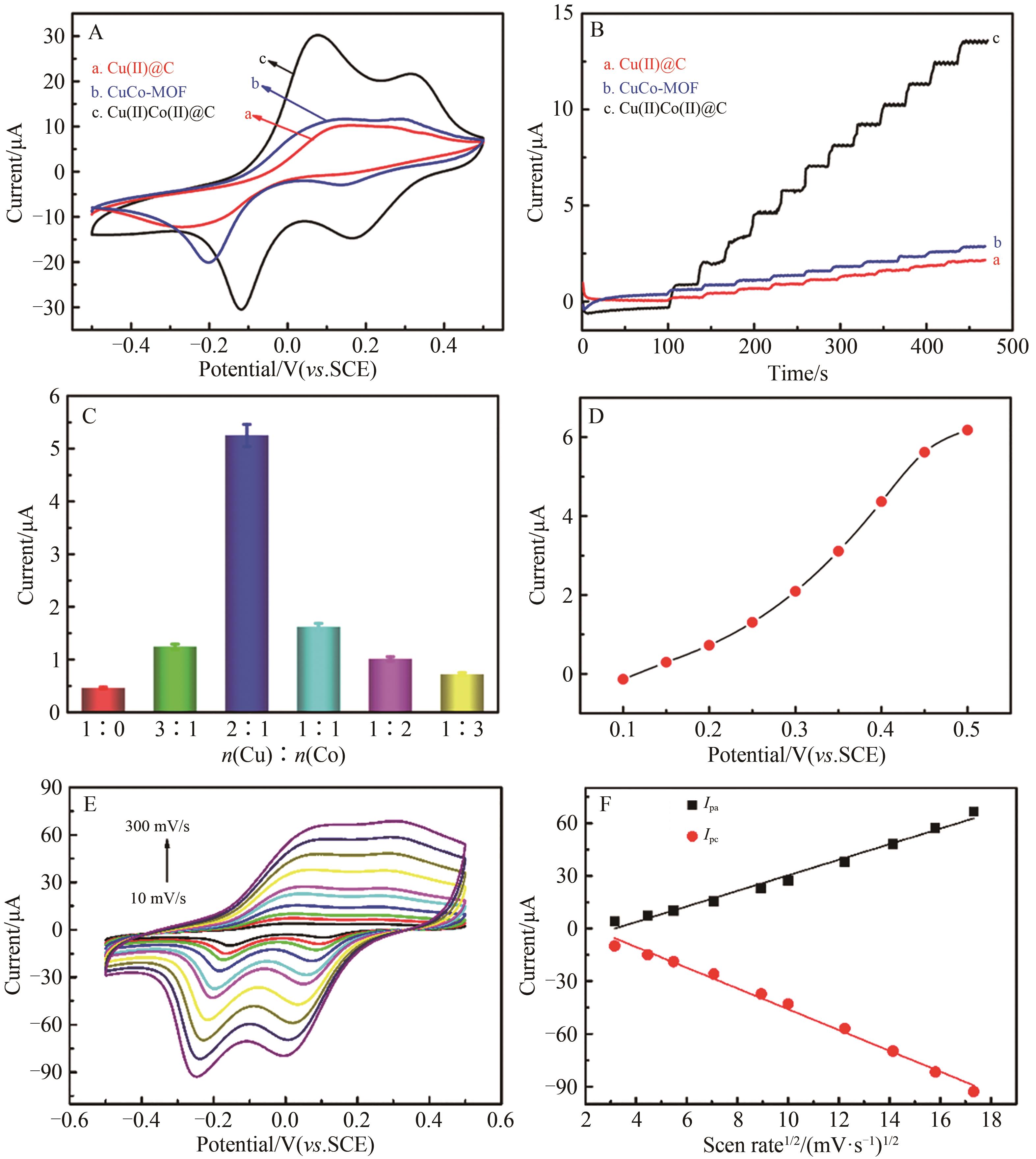
Fig.4 (A) CV curves of different materials in 0.10 mol/L NaOH solution containing 0.50 mmol/L glucose;` (B) The amperometric response of the current with time when an equal concentration of glucose solution is continuously added to 5 mL of 0.10 mol/L NaOH solution under stirring conditions. (a) Cu(Ⅱ)@C, (b) CuCo-MOF, (c) Cu(Ⅱ)Co(Ⅱ)@C; (C) Catalytic activity of Cu(Ⅱ)Co(Ⅱ)@C with six different n(Cu)∶ n(Co) to glucose; (D) Catalytic activity of Cu(Ⅱ)Co(Ⅱ)@C/GCE to glucose at different potentials; (E) CV curves of Cu(Ⅱ)Co(Ⅱ)@C/GCE at different scan rates from 10 to 300 mV/s in 0.10 mol/L NaOH solution containing 0.50 mmol/L glucose; (F) Linear plots of reduction peak and oxidation peak current vs. the square root of the scan rate. Supporting electrolyte is 0.10 mol/L NaOH solution
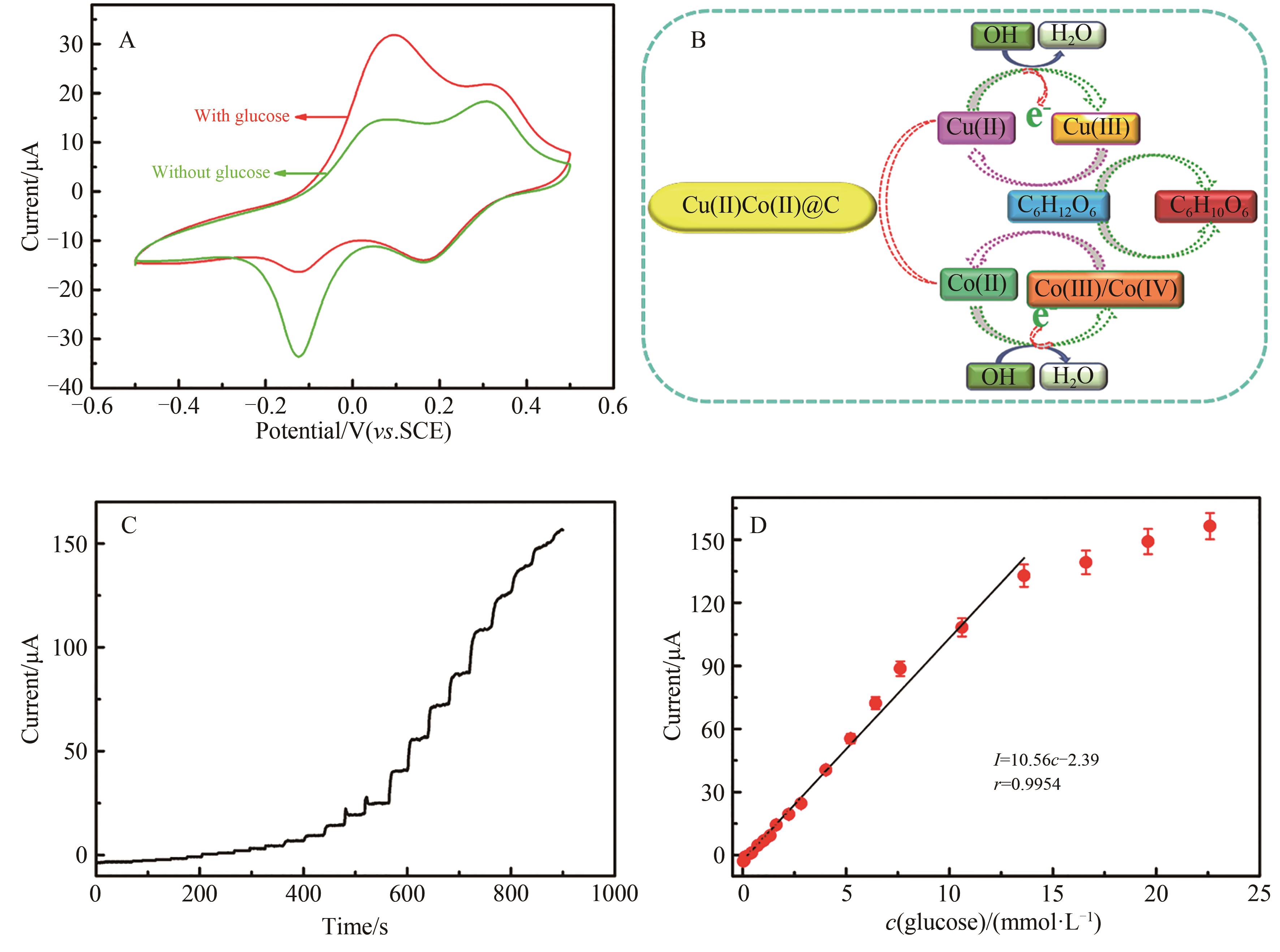
Fig. 5 (A) CV curves of Cu(Ⅱ)Co(Ⅱ)@C/GCE in 0.10 mol/L NaOH solution without glucose and with 0.50 mmol/L glucose; (B) Reaction mechanism diagram; (C) Amperometric response of Cu(Ⅱ)Co(Ⅱ)@C/GCE at 0.45 V by continuously injecting glucose; (D) The corresponding calibration plot of (C), error bars are the standard deviation of 3 measurements
| 传感器 | 检测范围 | 灵敏度 | 检测限 | 参考文献 |
|---|---|---|---|---|
| Sensor | Linear range | Sensitivity/(mA·L·cm-2·mmol-1) | LOD/(μmol·L-1) | Ref. |
| Pt-Ni NPs-MWCNTs/GCE | 7.0~16.0 mmol/L | 0.57 | 230 | [ |
| Cu@HHNs/GCE | 5 μmol/L~3 mmol/L | 1.59 | 1.97 | [ |
| Au@Ni/C/GCE | 0.5~10 mmol/L | 0.023 | 15.7 | [ |
| M-BDC MOF/GCE | 0.01~0.8 mmol/L | 0.64 | 6.68 | [ |
| NiCo NSs/GNR-GCE | 5 μmol/L~0.8 mmol/L | 0.34 | 0.6 | [ |
| Cu(Ⅱ)Co(Ⅱ)@C/GCE | 0.03 μmol/L~13.6 mmol/L | 10.56 | 0.01 | This work |
Table 1 Comparison of amperometric responses of the modified electrodes to glucose
| 传感器 | 检测范围 | 灵敏度 | 检测限 | 参考文献 |
|---|---|---|---|---|
| Sensor | Linear range | Sensitivity/(mA·L·cm-2·mmol-1) | LOD/(μmol·L-1) | Ref. |
| Pt-Ni NPs-MWCNTs/GCE | 7.0~16.0 mmol/L | 0.57 | 230 | [ |
| Cu@HHNs/GCE | 5 μmol/L~3 mmol/L | 1.59 | 1.97 | [ |
| Au@Ni/C/GCE | 0.5~10 mmol/L | 0.023 | 15.7 | [ |
| M-BDC MOF/GCE | 0.01~0.8 mmol/L | 0.64 | 6.68 | [ |
| NiCo NSs/GNR-GCE | 5 μmol/L~0.8 mmol/L | 0.34 | 0.6 | [ |
| Cu(Ⅱ)Co(Ⅱ)@C/GCE | 0.03 μmol/L~13.6 mmol/L | 10.56 | 0.01 | This work |
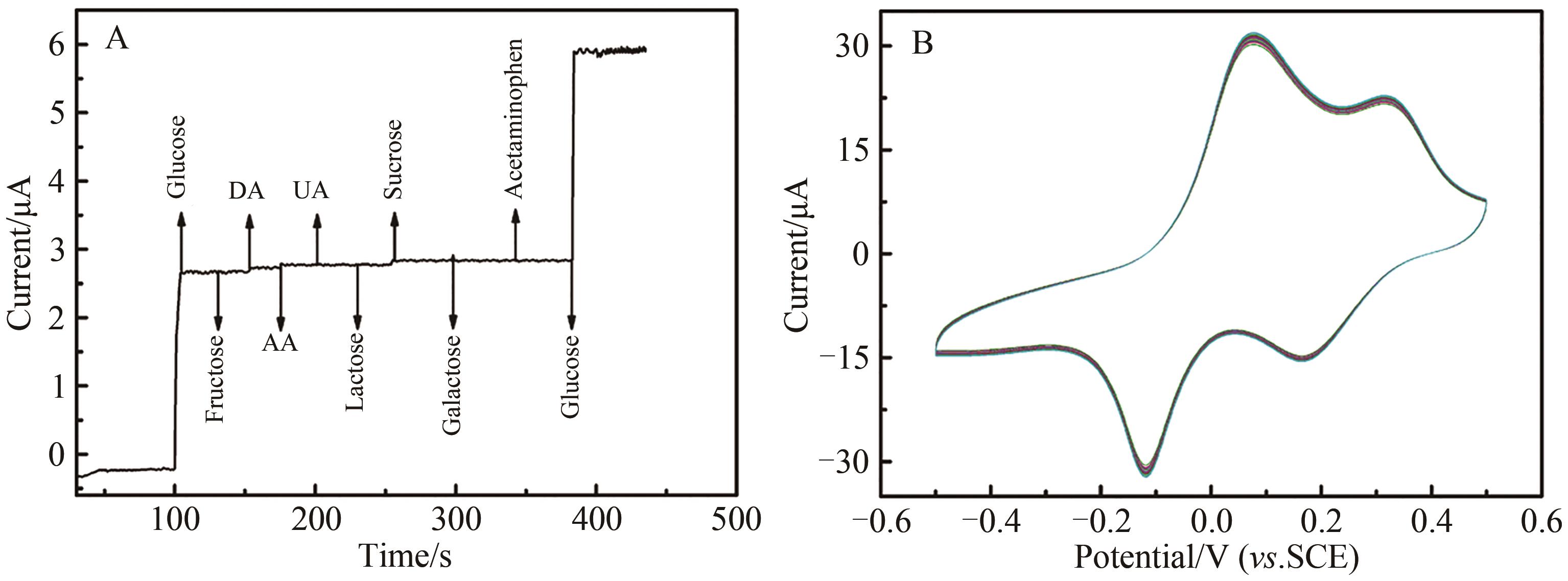
Fig 6 (A) Effects of Cu on glucose detection in 0.10 mol/L NaOH solution with 0.20 mmol/L fructose, dopamine (DA), ascorbic acid (AA), uric acid (UA), lactose, sucrose, galactose and paracetamol, respectively; (B) Stability of non-enzymatic glucose biosensors with scanning speed of 50 mV/s in 0.10 mol/L NaOH solution containing 0.50 mmol/L glucose
| 样品号 | 血清样品 | 葡萄糖加入量 | 实验值 | 医院测定值 | 回收率 | 相对标准偏差 |
|---|---|---|---|---|---|---|
| Sample No. | c(Original)/(μmol·L-1) | c(Added)/(μmol·L-1) | Found a / (μmol·L-1) | Determined by hospital b /(μmol·L-1) | Recovery/% | RSD% (n=3) |
| 1 | 50 | 10 | 61.23±3.8 | 60.46±3.2 | 102.1 | 4.2 |
| 2 | 100 | 20 | 122.1±3.2 | 123.24±2.6 | 101.7 | 3.8 |
| 3 | 200 | 50 | 245.6±8.1 | 247.1±5.4 | 98.2 | 2.4 |
| 4 | 400 | 100 | 484.5±18.6 | 479.5±19.3 | 96.3 | 2.9 |
Table 2 Appearance of the biosensor for determination the recovery of glucose
| 样品号 | 血清样品 | 葡萄糖加入量 | 实验值 | 医院测定值 | 回收率 | 相对标准偏差 |
|---|---|---|---|---|---|---|
| Sample No. | c(Original)/(μmol·L-1) | c(Added)/(μmol·L-1) | Found a / (μmol·L-1) | Determined by hospital b /(μmol·L-1) | Recovery/% | RSD% (n=3) |
| 1 | 50 | 10 | 61.23±3.8 | 60.46±3.2 | 102.1 | 4.2 |
| 2 | 100 | 20 | 122.1±3.2 | 123.24±2.6 | 101.7 | 3.8 |
| 3 | 200 | 50 | 245.6±8.1 | 247.1±5.4 | 98.2 | 2.4 |
| 4 | 400 | 100 | 484.5±18.6 | 479.5±19.3 | 96.3 | 2.9 |
| 1 | ZHU H, LI L, ZHOU W, et al. Advances in non-enzymatic glucose sensors based on metal oxides[J]. J Mater Chem B, 2016, 4: 7333-7349. |
| 2 | XIAO X, ZHENG S, LI X, et al. Facile synthesis of ultrathin Ni-MOF nanobelts for high-efficiency determination of glucose in human serum[J]. J Mater Chem B, 2017, 5: 5234-5239. |
| 3 | RADWAN A B, SREEDEVI P, CABIBIHAN J J. Superior non-invasive glucose sensor using bimetallic CuNi nanospecies coated mesoporous carbon[J]. Biosensers, 2021, 11: 463-468. |
| 4 | 毕宇芳. 2型糖尿病的全生命周期危险因素研究现状[J]. 内科理论与实践, 2021, 16: 373-375. |
| BI Y F. Research status of life cycle risk factors for type 2 diabetes mellitus[J]. J Int Med Concepts Practice, 2021, 16: 373-375. | |
| 5 | YIN S Y, LIU W, YANG J, et al. Synergistically enhanced multienzyme catalytic nanoconjugates for efficient cancer therapy[J]. J Mater Chem B, 2021, 9: 5877-5886. |
| 6 | CHEN R, XU W J, XIONG C Q, et al. High-salt-tolerance matrix for facile detection of glucose in rat brain microdialysates by maldi mass spectrometry[J]. Anal Chem, 2012, 84: 465-469. |
| 7 | HU Y H, CHENG H J, ZHAO X Z, et al. Surface-enhanced raman scattering active gold nanoparticles with enzyme-mimicking activities for measuring glucose and lactate in living tissues[J]. ACS Nano, 2017, 11: 5558-5566. |
| 8 | 袁春玲, 姚晓条, 徐远金, 等. 双功能碳点用于葡萄糖的比色/比率荧光测定[J]. 高等学校化学学报, 2021, 42(8): 2428-2435. |
| YUAN C L, YAO X T, XU Y J, et al. Colorimetry/ratio fluorimetry determination of glucose with bifunctional carbon dots[J].Chem J Chinese Univ, 2021, 42(8): 2428-2435. | |
| 9 | 车婷华, 谭潇, 晏嘉伟, 等. 铜修饰多孔镍自支撑电极的构建及其葡萄糖氧化性能[J]. 应用化学, 2019, 36(9): 1091-1098. |
| CHE T H, TAN X, YAN J W, et al. Synthesis of copper modified porous nickel self-supported electrode and its catalytic oxidation of glucose[J]. Chinese J Appl Chem, 2019, 36(9): 1091-1098. | |
| 10 | 彭红珍, 张瑜, 郭琳洁, 等. 一步原位还原法制备WS2@Au量子点复合物及其传感应用[J]. 应用化学, 2022, 39(3): 480-488. |
| PENG H Z, ZHANG Y, GUO L J, et al. Facile one-step synthesis of WS2@Au quantum dot composite by in situ reduction and its sensing application[J]. Chinese J Appl Chem, 2022, 39(3): 480-488. | |
| 11 | ZHANG X, LUO J S, TANG P Y, et al. Ultrasensitive binder-free glucose sensors based on the pyrolysis of in situ grown Cu MOF[J]. Sens Actuators B:Chem, 2018, 254: 272-281. |
| 12 | YU L, XIA B Y, WANG X, et al. General formation of M-MoS3 (M=Co,Ni) hollow structures with enhanced electrocatalytic activity for hydrogen evolution[J]. Adv Mater, 2016, 28: 92-97. |
| 13 | CHEN J Y, XU Q, SHU Y, et al. Synthesis of a novel Au nanoparticles decorated Ni-MOF/Ni/NiO nanocomposite and electrocatalytic performance for the detection of glucose in human serum[J]. Talanta, 2018, 184: 136-142. |
| 14 | LUO D, WU L, ZHI J. Fabrication of boron-doped diamond nanorod forest electrodes and their application in nonenzymatic amperometric glucose biosensing[J]. ACS Nano, 2009, 3(8): 2121-2128. |
| 15 | SHU Y, LI B, CHEN J, et al. Facile synthesis of ultrathin nickel cobalt phosphate 2D nanosheets with enhanced electrocatalytic activity for glucose oxidation[J]. ACS Appl Mater Inter, 2018, 10(3): 2360-2367. |
| 16 | SHAVANOVA K, BAKAKINA Y, BURKOVA I, et al. Application of 2D non-graphene materials and 2D oxide nanostructures for biosensing technology[J]. Sensors, 2016, 16(2): 223. |
| 17 | RAMALINGAM M, KOKULNATHAN T, TSAI P C, et al. Ultrasonication-assisted synthesis of gold nanoparticles decorated ultrathin graphitic carbon nitride nanosheets as a highly efficient electrocatalyst for sensitive analysis of caffeic acid in food samples[J]. App Nanosci, 2021, 254: 1-12. |
| 18 | KAILASA S, REDDY R, REDDY M, et al. High sensitive polyaniline nanosheets (PANINS)@rGO as non-enzymatic glucose sensor[J]. J Mater Sci:Mater Eletron, 2020, 31(4): 2926-2937. |
| 19 | YUAN Z, YANG C, GAO H, et al. High response formic acid gas sensor based on MoS2 nanosheets[J]. IEEE T Nanotechnol, 2021, 20: 177-184. |
| 20 | 王雨桐, 范卫东, 肖振宇, 等. 溶剂控制的铜基金属-有机框架物的合成与荧光性能[J]. 应用化学, 2017, 34(9): 1035-1045. |
| WANG Y T, FAN W D, XIAO Z Y, et al. Solvent-dependent synthesis and fluorescent properties of Cu(Ⅱ) metal-organic frameworks[J]. Chinese J Appl Chem, 2017, 34(9): 1035-1045. | |
| 21 | LIANG Z, CHONG Q, GUO W, et al. Metal-organic frameworks: pristine metal-organic frameworks and their composites for energy storage and conversion[J]. Adv Mater, 2018, 30(37): 1870276. |
| 22 | 王禹婷, 杨天怡, 章应辉. 卟啉框架材料在光催化领域的应用[J]. 应用化学, 2020, 37(6): 611-619. |
| WANG Y T, YANG T Y, ZHANG Y H. Application of porphyrin-based framework materials on photocatalysis[J]. Chinese J Appl Chem, 2020, 37(6): 611-619. | |
| 23 | 王艺蒙, 张申平, 葛宇, 等. 多孔双金属氧化物/碳复合光催化剂对四环素的高效光催化降解[J]. 物理化学学报, 2020, 36: 1905083, |
| WANG Y M, ZHANG S P, GE Y, et al. Highly efficient photocatalytic degradation of tetracycline using a bimetallic oxide/carbon photocatalyst[J]. Acta Phys-Chim Sin, 2020, 36: 1905083. | |
| 24 | 樊蕾, 江群英, 潘敏, 等. 基于模拟酶-天然酶级联反应的双模式传感平台用于生物标志物的超灵敏检测[J]. 化学学报, 2020, 78(5): 419-426. |
| FANG L, JIANG Q Y, PAN M. Dual-mode sensing of biomarkers by mimic enzyme-natural enzyme cascade signal amplification[J]. Acta Chim Sin, 2020, 78(5): 419-426. | |
| 25 | 万月, 宋美娜, 赵美廷. 二维金属有机框架纳米片的合成及在超电容和电催化领域的应用[J]. 高等学校化学学报, 2021, 42(2): 575-594. |
| WAN Y, SHONG M N, ZHAO M Y. Recent progress of two-dimensional metal-organic framework nanosheets for supercapacitor and electrocatalysis applications[J]. Chem J Chinese Univ, 2021, 42(2): 575-594. | |
| 26 | HOU Q, WU Y, ZHOU S, et al. Inside cover: ultra-tuning of the aperture size in stiffened ZIF-8_Cm frameworks with mixed-linker strategy for enhanced CO2/CH4 separation [J]. Angew Chem Int Ed, 2019, 58(1): 2-7. |
| 27 | LI R, CHEN T, PAN X. Metal-organic-framework-based materials for antimicrobial applications[J]. ACS Nano, 2021, 15: 3808-3848. |
| 28 | ABDINEJAD M, MOTLAGH M K, NOROOZIFAR M, et al. Electroreduction of carbon dioxide to formate using highly efficient bimetallic Sn-Pd aerogels[J].Mater Adv, 2022, 3: 1224-1230. |
| 29 | SADASIVUNI K K. Superior non-invasive glucose sensor using bimetallic CuNi nanospecies coated mesoporous carbon[J]. Biosensors, 2021, 11: 463. |
| 30 | LONG L, LIU X J, CHEN L L, et al. MOF-derived 3D leaf-like CuCo oxide arrays as an efficient catalyst for highly sensitive glucose detection[J]. Electrochim Acta, 2019, 308: 243-252. |
| 31 | DING Y L, SUN H D, REN C R, et al. A Nonenzymatic glucose sensor platform based on specific recognition and conductive polymer-decorated CuCo2O4 carbon nanofibers[J]. Materials 2020, 13: 2874. |
| 32 | CHEN A R, DING Y, YANG Z M, et al. Constructing heterostructure on highly roughened caterpillar-like gold nanotubes with cuprous oxide grains for ultrasensitive and stable nonenzymatic glucose sensor[J].Biosens Bioelectron, 2015, 74: 967-973. |
| 33 | 匡芮. 过渡金属(铜、钴)—有机纳米聚合物的可控制备及催化和传感性质研究[D]. 济南: 山东师范大学, 2017. |
| KUANG R. Controllable preparation and catalytic and sensing properties of transition metal (Cu, Co)-organic nanopolymers[D]. Jinan: Shandong Normal University, 2017. | |
| 34 | ZABIHI M, KHORASHEH F, SHAYEGAN J. Supported copper and cobalt oxides on activated carbon for simultaneous oxidation of toluene and cyclohexane in air[J]. RSC Adv, 2015, 5: 5107-5122. |
| 35 | SUN K, GAO X F, BAI Y X, et al. Synergetic catalysis of bimetallic copper-cobalt nanosheets for direct synthesis of ethanol and higher alcohols from syngas[J]. Catal Sci Technol, 2018, 8: 3936-3947. |
| 36 | LIU S Y, TENG L, ZHAO Y M, et al. Facile route to synthesize porous hierarchical Co3O4/CuO nanosheets with high porosity and excellent NOx sensing properties at room temperature[J]. Appl Surf Sci, 2018, 450: 91-101. |
| 37 | WANG L, XING H, GAO S, et al. Porous flower-like NiO@Graphene composites with superior microwave absorption properties[J]. J Mater Chem C, 2017, 5: 2005-2014. |
| 38 | AMRI A, DUAN X F, YIN C Y, et al. Solar absorptance of copper-cobalt oxide thin film coatings with nano-size, grain-like morphology: optimization and synchrotron radiation XPS studies[J]. Appl Surf Sci, 2013, 275: 127-135. |
| 39 | ZHANG Y, HUANG J W, DING Y. Porous Co3O4/CuO hollow polyhedral nanocages derived from metal-organic frameworks with heterojunctions as efficient photocatalytic water oxidation catalysts[J]. Appl Catal B, 2016, 198: 447-456. |
| 40 | LIU S Y, TENG L, ZHAO Y M, et al. Facile route to synthesize porous hierarchical Co3O4/CuO nanosheets with high porosity and excellent NOx sensing properties at room temperature[J]. Appl Surf Sci, 2018, 450: 91-101. |
| 41 | FENG Y, XIANG D, QIU Y R, et al. MOF-derived spinel NiCo2O4 hollow nanocages for the construction of non-enzymatic electrochemical glucose sensor[J]. Electroanalysis, 2020, 32: 571-580. |
| 42 | ZHOU D, CAO X, WANG Z, et al. Fe3N-Co2N nanowires array: a non-noble-metal bifunctional catalyst electrode for high-performance glucose oxidation and H2O2 reduction toward non-enzymatic sensing applications[J]. Chem-Eur J, 2017, 23(22): 5214-5218. |
| 43 | CHAKRABORTY P, DHAR S, DEKA N, et al. Non-enzymatic salivary glucose detection using porous CuO nanostructures[J]. Sens Actuators B: Chem, 2020, 302: 127134. |
| 44 | NAIK K K,SAHOO S,ROUT C S. Facile electrochemical growth of spinel copper cobaltite nanosheets for non-enzymatic glucose sensing and supercapacitor applications[J]. Micropor Mesopor Mat, 2017, 244: 226-234. |
| 45 | SUN A, ZHENG J, SHENG Q. A highly sensitive non-enzymatic glucose sensor based on nickel and multi-walled carbon nanotubes nanohybrid films fabricated by one-step co-electrodeposition in ionic liquids[J]. Electrochim Acta, 2012, 65: 64-69. |
| 46 | ARMITA N, MOHAMMAD S S, SAEED S K, et al. Fabrication of a microdialysis-based nonenzymatic microfluidic sensor for regular glucose measurement[J]. Sens Actuators B: Chem, 2021, 333: 129569. |
| 47 | ZHU Q Z, HU S Y, ZHANG L Q, et al. Reconstructing hydrophobic ZIF-8 crystal into hydrophilic hierarchically-porous nanoflowers as catalyst carrier for nonenzymatic glucose sensing[J]. Sens Actuators B: Chem, 2020, 313: 128031. |
| 48 | GAO X J, DU X Z, LIU D Y, et al. Core-shell gold-nickel nanostructures as highly selective and stable nonenzymatic glucose sensor for fermentation process[J]. Sci Rep-UK, 2020, 10(1): 1365-1372. |
| 49 | GUMILAR G, KANETI Y V, HENZIE J, et al. General synthesis of hierarchical sheet/plate-like M-BDC (M=Cu, Mn, Ni, and Zr) metal-organic frameworks for electrochemical non-enzymatic glucose sensing[J]. Chem Sci, 2020, 11: 3644-3655. |
| 50 | ASADIAN E, SHAHROKHIAN S, ZAD A I. Highly sensitive nonenzymetic glucose sensing platform based on MOF-derived NiCo LDH nanosheets/graphene nanoribbons composite[J]. J Electroanal Chem, 2018, 808: 114-123. |
| 51 | LIAO S H, LU S Y, BAO S J, et al. NiMoO4 nanofibres designed by electrospining technique for glucose electrocatalytic oxidation[J]. Sens Actuators B: Chem, 2016, 905: 72-78. |
| [1] | Peng-Hui FAN, Jie LIU, Sheng-Hui LOU, Tao TANG. Research Progress on Synergists of Phosphorous Flame Retardants in Epoxy Resin [J]. Chinese Journal of Applied Chemistry, 2023, 40(5): 653-665. |
| [2] | Ying LI, Yun ZHANG, Liang-Liang LIN, Hu-Jun XU. Synergistic Effect of Ternary Compound System of Sodium N‑Lauroyl Methylalanine [J]. Chinese Journal of Applied Chemistry, 2022, 39(8): 1262-1273. |
| [3] | Jing TANG, Na ZHANG, Dong-Xu SHI, Fang-Hui ZHANG, Jian-Jie TANG. Synthesis of UiO-66-NH2Grafted Pyridineimine Cobalt Catalyst and Its Catalytic Performance in Ethylene Oligomerization [J]. Chinese Journal of Applied Chemistry, 2022, 39(02): 258-265. |
| [4] | BI Yipiao, GONG Xue, YANG Fa, RUAN Mingbo, SONG Ping, XU Weilin. Polyvalent MnOx/C Electrocatalyst for Highly Efficient Nitrogen Reduction Reaction [J]. Chinese Journal of Applied Chemistry, 2020, 37(9): 1048-1055. |
| [5] | WANG Yuting,YANG Tianyi,ZHANG Yinghui. Application of Porphyrin-Based Framework Materials on Photocatalysis [J]. Chinese Journal of Applied Chemistry, 2020, 37(6): 611-619. |
| [6] | LIN Yongcen, DONG Xue, MA Yuqin, ZHAO Lang. Designed Formation of NiCo-Layered Double Hydroxide Derived from Zeolitic Imidazolate Framework-67 with Selective Dye Adsorption Property [J]. Chinese Journal of Applied Chemistry, 2020, 37(6): 683-694. |
| [7] | CHEN Jiaqi, ZHOU Yan, SUN Jingwen, ZHU Junwu, WANG Xin, FU Yongsheng. Recent Progress of Metal Organic Frameworks-Based Hollow Materials [J]. Chinese Journal of Applied Chemistry, 2020, 37(11): 1221-1235. |
| [8] | GONG Wenpeng, CHEN Dan, YANG Shuijin. Adsorption of Methyl Violet by an Anionic Metal-Organic Framework Cu(BDC-NH2)(4,4'-Bipy)0.5 (BDC=Terephthalicacid, Bipy=Bipyridine) [J]. Chinese Journal of Applied Chemistry, 2017, 34(11): 1321-1328. |
| [9] | GONG Wenpeng, KE xiaofen, LI Zhipeng, TIAN Chaoqiang, YANG Shuijin. Adsorption of Methylene Blue by Phosphomolybdiumtungstic Acid Decorated Metal Organic Framework MOF-5 [J]. Chinese Journal of Applied Chemistry, 2016, 33(9): 1047-1055. |
| [10] | CHAEMCHUEN Somboon, ZHOU Kui, YAO Chen, LUO Zhixiong, VERPOORT Francis. Alkali-Metal Tuning of Adsorption Sites in Metal Organic Frameworks MOF-5 for Carbon Dioxide/Methane Separation at Ambient Conditions [J]. Chinese Journal of Applied Chemistry, 2015, 32(5): 552-556. |
| [11] | CHEN Qi, FEI Xia, HE Qinqin, WU Qiliang, HE Bing, LIU Xueting*. Synthesis, Characterization and Synergistic Effect of Tb-loaded Mesoporous Titanium Dioxide [J]. Chinese Journal of Applied Chemistry, 2014, 31(10): 1222-1228. |
| [12] | Lu Changqing, Han Yinglin, Ma Yingjun, Zhao Renhui, Diao Yuemin. Performance and Synergistic Effect of Scale Inhibitors [J]. Chinese Journal of Applied Chemistry, 1996, 0(1): 83-85. |
| Viewed | ||||||
|
Full text |
|
|||||
|
Abstract |
|
|||||
